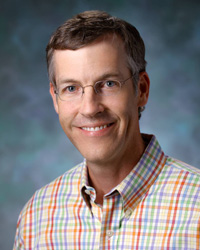Espenshade’s work called ‘brilliantly conceived and flawlessly executed’
The ¬È∂π¥´√Ω…´«È∆¨ and ¬È∂π¥´√Ω…´«È∆¨ Biology has named , associate professor of cell biology at Johns Hopkins University, the winner of the society’s .

Peter Espenshade
About the award
The Avanti Young Investigator Award in Lipid Research, established by ASBMB’s Lipid Research Division, recognizes outstanding research contributions in the area of lipids by young investigators with no more than 15 years of experience since receiving their degrees (Ph.D. or M.D.). The award consists of a plaque, $2,000, and transportation and expenses to present a lecture at the 2012 ASBMB annual meeting.
According to Peter Devreotes from Johns Hopkins University, the implications of Espenshade’s work are “critical to research into the nature and prevention of cardiovascular disease and stroke.” Moreover, his multifaceted research on how cells regulate both oxygen levels and production of cholesterol “for the first time united the fields of sterol synthesis and oxygen regulation,” said Nobel laureate Michael Brown, with whom Espenshade trained as a postdoctoral fellow. “His work is original, brilliantly conceived and flawlessly executed.”
Randy Hampton, professor of biology at the University of California, San Diego, agreed. “Espenshade has an incredible sense of where to look to find really fascinating and important things – and what to do to turn them into great stories and lines of inquiry.”
After graduating summa cum laude from Princeton University, Espenshade completed his Ph.D. in biology at the Massachusetts Institute of Technology in 1997. During his postdoctoral fellowship with Brown and fellow Nobel laureate Joseph Goldstein at the University of Texas Southwestern Medical Center at Dallas, Espenshade used mammalian cell systems to decipher pathways involved in environmental sensing, in particular focusing on cholesterol homeostasis.
In 2003, he moved to his current position at Johns Hopkins, where he expanded his research to incorporate the fission yeast Schizosaccharomyces pombe as a model system. Espenshade’s ability to “exploit the strengths of both fungal and mammalian model systems to make paradigm-shifting discoveries” led Devreotes to nominate Espenshade for the award. “I have no doubt that his future achievements will be even more prominent.”
Espenshade will receive his award during the Experimental Biology 2012 conference in San Diego, where he will deliver an award lecture. The presentation will take place at 9:55 a.m. April 23 in the San Diego Convention Center.
Enjoy reading ASBMB Today?
Become a member to receive the print edition four times a year and the digital edition weekly.
Learn moreGet the latest from ASBMB Today
Enter your email address, and we’ll send you a weekly email with recent articles, interviews and more.
Latest in People
People highlights or most popular articles

ASBMB names 2025 fellows
¬È∂π¥´√Ω…´«È∆¨ and ¬È∂π¥´√Ω…´«È∆¨ Biology honors 24 members for their service to the society and accomplishments in research, education, mentorship, diversity and inclusion and advocacy.

When Batman meets Poison Ivy
Jessica Desamero had learned to love science communication by the time she was challenged to explain the role of DNA secondary structure in halting cancer cell growth to an 8th-grade level audience.

The monopoly defined: Who holds the power of science communication?
“At the official competition, out of 12 presenters, only two were from R2 institutions, and the other 10 were from R1 institutions. And just two had distinguishable non-American accents.”

In memoriam: Donald A. Bryant
He was a professor emeritus at Penn State University who discovered how cyanobacteria adapt to far-red light and was a member of the ¬È∂π¥´√Ω…´«È∆¨ and ¬È∂π¥´√Ω…´«È∆¨ Biology for over 35 years.

 Yes, I have an accent — just like you
When the author, a native Polish speaker, presented her science as a grad student, she had to wrap her tongue around the English term “fluorescence cross-correlation microscopy.”

Professorships for Booker; scholarship for Entzminger
Squire Booker has been appointed to two honorary professorships at Penn State University. Inayah Entzminger received a a BestColleges scholarship to support their sixth year in the biochemistry Ph.D. program at CUNY.

